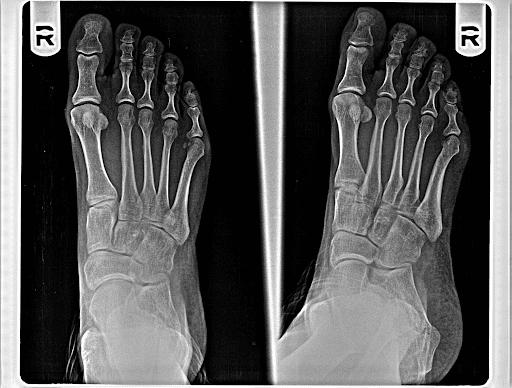Understanding Stress Fractures in the Foot: From Diagnosis to Treatment
By Dr. Jenneffer Pulapaka, DPM, Podiatric Wound Care Surgeon
Stress fractures in the foot are a common yet often overlooked injury, especially among athletes and individuals involved in high-impact activities. These tiny cracks in the bone can cause significant pain and discomfort, potentially leading to long-term complications if left untreated.
Symptoms and Early Diagnosis:
The most common symptom of a stress fracture in the foot is pain, typically originating from a specific location and worsening with weight-bearing activities like walking, running, or jumping. Other symptoms might include:
- Swelling
- Tenderness
- Bruising
- Difficulty bearing weight
- A popping or snapping sensation
Early diagnosis of stress fractures is crucial to prevent further damage and ensure optimal healing. However, this can be challenging due to the subtle nature of the symptoms, and misdiagnosis is not uncommon.
Complications of Missed Diagnosis:
Ignoring stress fractures can lead to several complications, including:
- Complete fracture: If the bone continues to undergo stress, the hairline crack can progress to a complete fracture, requiring more extensive treatment like surgery.
- Nonunion: In some cases, the stress fracture may not heal properly, leading to a nonunion, a condition where the bone fragments fail to join together.
- Osteomyelitis: This is a potentially serious bone infection that can occur if the stress fracture remains untreated and allows bacteria to enter the bone.
Recent Research on Stress Fractures:
Recent research has shed light on several important aspects of stress fractures, including:
- Risk factors: Studies have identified specific risk factors that make individuals more susceptible to stress fractures, such as female athletes, individuals with osteoporosis, and those participating in repetitive high-impact activities.
- Imaging techniques: Advancements in imaging technology like MRI scans have improved the accuracy of diagnosis and allowed for earlier detection of stress fractures.
- Treatment options: New treatment options are emerging, such as platelet-rich plasma (PRP) injections, which have shown promising results in promoting healing and reducing pain.
Treatment Options for Stress Fractures:
The specific treatment for a stress fracture will depend on its severity and location. Common treatment options include:
- Rest and immobilization: This is the mainstay of treatment, allowing the bone to heal properly. Sometimes, a walking boot, cast, or crutches may be needed.
- Ice and pain medication: These can help manage pain and reduce swelling.
- Physical therapy: Once the pain has subsided, physical therapy can help regain strength and flexibility in the affected foot.
- Bone stimulator: A bone growth stimulator may be prescribed if the bone is healing slowly with continued pain. This device sends electromagnetic or ultrasound waves to promote bone healing. The device can be implanted under the skin or outside of it.
- Surgery: In rare cases, surgery may be necessary to repair a severe stress fracture or nonunion.
Preventing Stress Fractures:
Several strategies can help prevent stress fractures:
- Gradual increase in activity: When starting a new exercise program, gradually increase the intensity and duration to allow your bones to adapt to the stress.
- Proper footwear: Wear supportive shoes designed for your specific activity.
- Maintain bone health: Ensure adequate calcium, vitamin K2-MK7, and vitamin D intake through diet and supplements if necessary.
- Cross-training: Incorporate different types of exercise into your routine to avoid putting excessive stress on the same bones.
- Listen to your body: Pay attention to pain and avoid activities that cause discomfort.
Conclusion:
Stress fractures are a common yet potentially serious problem. By understanding the symptoms, risks, and treatment options, you can take steps to prevent them and ensure optimal healing if they occur. If you suspect a stress fracture in your foot, it is crucial to consult a podiatrist for prompt diagnosis and appropriate treatment.
Dr. Jenneffer Pulapaka, DPM, is a Board-certified Podiatric Wound Care Surgeon specializing in the diagnosis and management of foot and ankle conditions. She provides comprehensive care for patients with stress fractures, diabetic foot ulcers, and other complex wounds.
Related Articles
Related
Culinary Panel
The Intersection of Podiatry and Gastronomy: A Tale of Culinary Healing Welcome to a vibrant exploration of Podiatric Lifestyle Medicine and the Food as Medicine philosophy, with a spotlight on the extraordinary work of chefs and medical professionals who craft...
Library Calendar Q2-2024
Spring into Action with Volusia County Libraries! Fun Activities + Happy Feet with Deland Foot & Leg CenterSpring into Action with Volusia County Libraries! Welcome to the season of new beginnings! Volusia County Libraries is excited to unveil our calendar for...
Role of Podiatry in Holistic Wellbeing and Lifestyle Medicine
The Underrated Role of Podiatry in Holistic Wellbeing and Lifestyle Medicine By Dr. Jenneffer Pulapaka, DPM, Podiatric Wound Care Surgeon When most people think about their health and...
